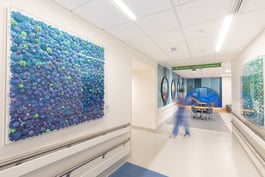Creating environments where every individual feels seen, valued, and welcomed requires an intentional, evidence-based approach. In healthcare settings, designing for belonging is particularly crucial, as the physical environment directly impacts patient preference, staff retention, and community health, ultimately creating a powerful competitive advantage.
The Hospital as a Community Partner
There is a growing recognition that social and economic conditions are key drivers of health outcomes. Healthcare facilities have profound environmental, financial, and political impacts within their communities that can influence these sectors (Plott et al., 2022). Hospitals have a unique and important role to play in addressing these health disparities and contributing to the overall well-being of the populations they serve (Santos & Lindrooth, 2021). Value-based care models can support this broader responsibility as financial incentives are increasingly tied to population health outcomes rather than the volume of services provided.
Ultimately, this outward focus creates a powerful return. In an increasingly consumer-driven market, patients and their families are drawn to providers who make them feel welcome and who offer a more personal, human-centric experience. By building a reputation as a vital community asset, a hospital enhances its brand, builds patient loyalty, and becomes a preferred destination for receiving care and attracting top-tier talent.
The hospital’s built environment is central to this mission. An intentionally designed environment is not only more operationally efficient but also demonstrably improves patient and staff outcomes by reducing stress, alleviating pain, and expediting recovery. The patient experience is a key differentiator, and therefore, the creation of an inclusive and welcoming atmosphere is a strategic priority (Palityka & Chrysikou, 2024; Gregory et al., 2022)
Core Principles for Designing Inclusive Healthcare Environments
Co-Creation and Community Reflection. An inclusive environment must be co-created in partnership with the community it serves. The design process is most effective when it incorporates diverse viewpoints, such as through engaging different stakeholders and including patients, staff, and community members with a range of interests, needs, and abilities. An evidence-based art program serves as a key catalyst for this co-creation. Engaging local artists and community groups in the curation process can ensure that a hospital’s art collection, and ultimately overall environment and brand, genuinely reflect the community’s identity, culture, and values. This, in turn, fosters a sense of ownership and pride among staff, patients, and community members (Couper et al., 2023; Mosca & Coapolongo, 2023).
Biophilic Design and Creating Restorative Spaces. Biophilic design is a powerful tool for creating safe, calming, and restorative healthcare spaces. Studies consistently demonstrate that patients exhibit a strong preference for art depicting natural scenes and confirm the therapeutic benefits of incorporating natural elements and imagery into hospital design. The clinical impacts of this exposure include reductions in pain, anxiety, blood pressure, and heart rate. Hospital art programs provide an optimal method for integrating biophilic principles throughout a facility, offering a positive distraction and a connection to the world outside, particularly in interior, otherwise sterile, clinical spaces that lack windows or direct access to nature (Fudickar et al., 2022; Nielsen et al., 2017).
Fostering Social Connection and Equity. An inclusive hospital design must support users’ social and emotional needs, facilitating outlets for positive interaction and distraction. Art functions as a scalable solution, providing a common frame of reference that stimulates dialogue and interaction among patients, visitors, and staff. Studies have observed that the presence of art, whether figurative or abstract, increases the frequency of social interactions in shared spaces (Fudickar et al., 2022; Nielsen et al., 2017).
Furthermore, a thoughtfully curated art collection is a powerful visible statement of equity. A core universal design tenet is the creation of non-stigmatizing environments that welcome and respect all user groups. This message is crucial to communicate in care settings, and an art collection that reflects a range of cultures, abilities, and experiences reflects it clearly. A commitment to inclusivity is further reinforced through the incorporation of accessible art, such as tactile sculptures or works that include audio-visual elements, which ensures that the therapeutic benefits of art are available to all individuals (Mosca & Coapolongo, 2023; Bradley, 2020).
Art as a Strategic Institutional Asset
An evidence-based art program is a strategic investment in a hospital’s foundational mission. For patients, it contributes to improved clinical outcomes, reduced stress, and an enhanced sense of safety and well-being. For staff, an aesthetically restorative environment improves resilience, satisfaction, and overall well-being, which is particularly crucial in high-stress clinical settings. Ultimately, it cultivates a strong institutional reputation as a caring, innovative, and community-focused organization that delivers superior, human-centered care (Fudickar et al., 2022; Gregory et al., 2022; Plott et al., 2022).
How TurningArt Can Help
At TurningArt, we translate the principles of designing for belonging into actionable, evidence-based art programs. We specialize in creating art collections that are strategically aligned with your healthcare center’s mission, communicate your values, and support outcomes. Our advisors work with you to develop collections that resonate with patients, visitors, and staff alike. Let us help you transform your physical space into a strategic asset that builds trust, fosters well-being, and supports exceptional care, and connect with an Art Advisor below!


Connect with an Art Advisor below to learn more!

.jpg?width=332&height=177&name=_MG_0840%20copy%20(2).jpg)


.jpg?width=332&height=177&name=dtBv_067_DSC_2139_DaNil%20(2).jpg)


